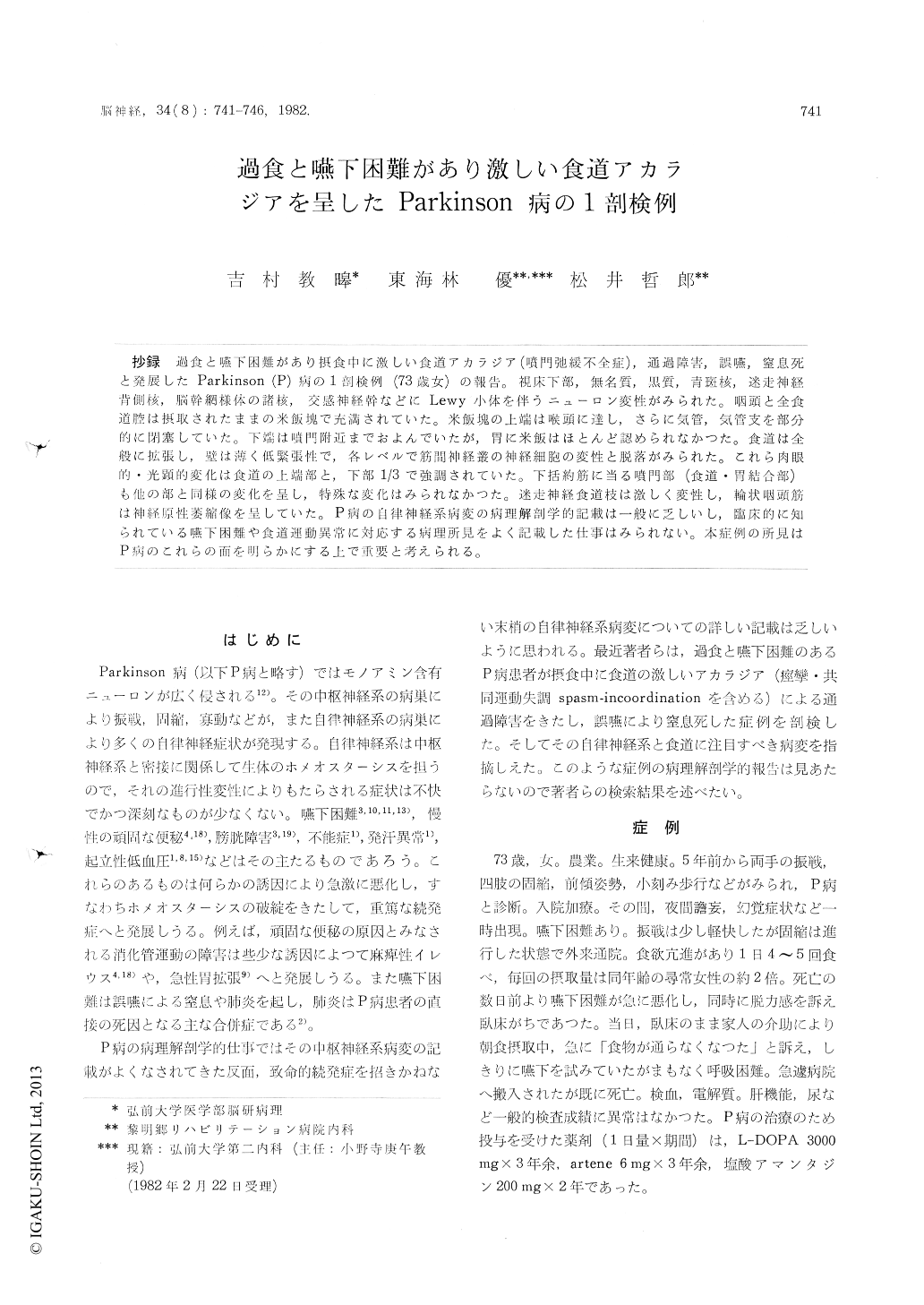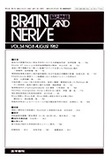Japanese
English
- 有料閲覧
- Abstract 文献概要
- 1ページ目 Look Inside
抄録 過食と嚥下困難があり摂食中に激しい食道アカラジア(噴門弛緩不全症),通過障害,誤嚥,窒息死と発展したParkinson(P)病の1剖検例(73歳女)の報告。視床下部,無名質,黒質,青斑核,迷走神経背側核,脳幹網様体の諸核,交感神経幹などにLewy小体を伴うニューロン変性がみられた。咽頭と全食道腔は摂取されたままの米飯塊で充満されていた。米飯塊の上端は喉頭に達し,さらに気管,気管支を部分的に閉塞していた。下端は噴門附近までおよんでいたが,胃に米飯はほとんど認められなかつた。食道は全般に拡張し,壁は薄く低緊張性で,各レベルで筋間神経叢の神経細胞の変性と脱落がみられた。これら肉眼的・光顕的変化は食道の上端部と,下部1/3で強調されていた。下括約筋に当る噴門部(食道・胃結合部)も他の部と同様の変化を呈し,特殊な変化はみられなかつた。迷走神経食道枝は激しく変性し,輪状咽頭筋は神経原性萎縮像を覧していた。P病の自律神経系病変の病理解剖学的記載は一般に乏しいし,臨床的に知られている嚥下困難や食道運動異常に対応する病理所見をよく記載した仕事はみられない。本症例の所見はP病のこれらの面を明らかにする上で重要と考えられる。
An autopsy report of Parkinsonian patient who had manifested a concurrence of hyperphagia with dysphagia followed by severe achalasia (disorder of motility) of the esophagus was made.
Neuronal degeneration in the form of Lewy bodies was evidently observed in the hypotha-lamus, substantia nigra et innominata, locus coeruleus, dorsal motor nucleus of the vagus nerve, some nuclei in the reticular formation of the brain stem, and ganglia of the sympathetic trunk. In addition, there was simple neuronal atrophy in the cerebral cortex, globus pallidus, and intermediolateral nucleus of the spinal cord.
Dilatation of the esophagus with thinning and atonia of the wall was noted, together with the presence of degeneration of ganglion cells in the myenteric and submucous plexi : these changes were accentuated in the uppermost part and the lower third of the esophagus. The entire eso-phageal lumen was filled with a mass of boiled rice which extended up to the pharynx and larynx and into the trachea and bronchi to obstruct their lumina. Caudally, it reached the close vicinity to the cardia, whereas little was seen in the stomach which was normal in appe-arance.
There were conspicuous degeneration of axons in the esophageal branches of the vagus nerve and neurogenic atrophy of the cricopharyngeus muscle.
The origination and development of those eso-phageal alterations were regarded as to be due to the above-described degeneration of pre- and postganglionic neurons in both sympathetic and parasympathetic nerves in charge of innervating the esophagus. Factors considered to have facili-tated the so abnormal extention of the mass of rice as to fill the esophagus and to reach the larynx were discussed.
Although dysphagia and abnormal motility of the esophagus in Parkinson's disease have long been noted clnically and radiologically, there have been no detailed descriptions of patho-anatomical findings responsible for those clinical problems. The present study may make a good contribution to elucidating the autonomic nervous lesions, and the pathogenesis of dysphagia and abnormal motility of the esophagus in Parkinson's disease.

Copyright © 1982, Igaku-Shoin Ltd. All rights reserved.


